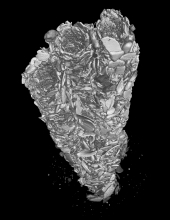*Adhesive gland transcriptomics uncovers a diversity of genes involved in glue formation in marine tube-building polychaetes. Buffet, J-P, Corre, E, Duvernois-Berthet, E, Fournier, J, Lopez, PJ. Acta Biomaterialia, Available online 27 March 2018, ISSN 1742-7061, https://doi.org/10.1016/j.actbio.2018.03.037
The diversity of bioadhesives elaborated by marine invertebrates is a tremendous source of inspiration to develop biomimetic approaches for biomedical and technical applications. In collaboration with Saint Gobain Isover, our project aims to develop novel bio-adhesives, inspired by marine tube-building polychaetes.
We focused our study* on two polychaete worm species belonging to the Sabellariidae family (sand castle worms), Sabellaria alveolata (from European temperate areas) and Phragmatopoma caudata (from American tropical areas). Sand castle worms are capable of forming vast reefs in highly turbulent marine habitats and build composite tubes as protective houses using sand grains and shell clasts. The cohesion of the tubes is ensured by a cement composed of proteins, polymers and divalent cations. Here, we performed transcriptomic analyses to investigate the genes that are differentially expressed in the parathorax region, which contains the adhesive gland and tissues, from the rest of the body.
We found a large number of candidate genes to be involved in the adhesive process. Our results suggest that sabellariid cement is likely to be composed by a large diversity of structural proteins. Moreover, these new genomic resources help to identify enzymes putatively involved in the chemistry of the adhesive process, such as tyrosinases, peroxidases and kinases. These enzymes may correspond to new targets to develop bio-inspired approaches.
BOREA contact:
Jean-Philippe Buffet, jeanphilippe.buffet@gmail.com
Pascal Jean Lopez, pjlopez@mnhn.fr


